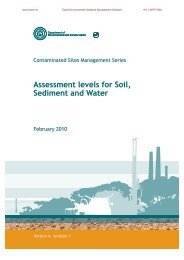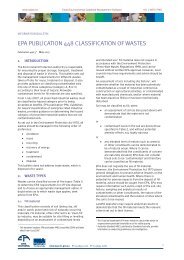Soil Generic Assessment Criteria for Human Health Risk ... - ESdat
Soil Generic Assessment Criteria for Human Health Risk ... - ESdat
Soil Generic Assessment Criteria for Human Health Risk ... - ESdat
Create successful ePaper yourself
Turn your PDF publications into a flip-book with our unique Google optimized e-Paper software.
www.esdat.net Esdat Environmental Database Management Software +61 2 8875 7948<br />
Di n butyl phthalate, Di butyl phthalate or<br />
DBP<br />
Scientific Committee on Food (SCF) pre 2002<br />
Rat, 90 day and 1<br />
year oral,<br />
reproduction and<br />
teratogenicity.<br />
Limited 90-day and 1 year oral rat studies oral<br />
reproduction and tetratogenicity studies, limited<br />
mutagenicity studies (RIVM May 1998). Needed : tests<br />
<strong>for</strong> gene mutation and if migration exceeds 0.05mg/kg<br />
28 oral study and peroxisome proliferation study too.<br />
Compilation of the Evaluations of the scientific committee on food on certain<br />
monomers and additives used in the manufacture of plastics materials<br />
intended to come into contact with food Stuffs Until 21 March 1997 SCF<br />
1999<br />
http://ec.europa.eu/food/fs/sc/scf/reports/scf_reports_42.pdf<br />
European Centre <strong>for</strong> Ecotoxicology and<br />
Toxicology of Chemicals (ECETOC)<br />
Rat, 2 generation<br />
reproductive<br />
Reduced pup weights observed in a 2 generation<br />
reproductive study with rats<br />
Reduced pup weights<br />
EU Scientific Committee on Toxicity, Ecotoxicity and the Environment http://ec.europa.eu/health/ph_risk/committees/sct/documents/out12_en.<br />
(CSTEE). Phthalate migration from soft PVC toys and child care articles pdf<br />
Opinion expressed at the CSTEE third plenary meeting Brussels 24 April 1998<br />
ICPS Environmental <strong>Health</strong> <strong>Criteria</strong> (EHC)<br />
Monographs<br />
Rat, 2 generation<br />
reproductive<br />
Rat, reproductive,<br />
fertility,<br />
developmental<br />
2 generation rat study in evaluation of risk of<br />
reproductive toxicity. - male reproductive system<br />
considered to be main target. Also details a NOAEL<br />
(50mg/kg bw/day) and LOAEL (100mg/kg bw/day) <strong>for</strong> 1<br />
generation study.<br />
NB. The severe, possibly irreversible, teratogenic,<br />
testicular and epididymal effects were only observed<br />
at the highest dose levels, which also produced other<br />
signs of toxicity. Because DBP is rapidly metabolized<br />
and eliminated, with no evidence of accumulation, no<br />
additional factor was incorporated <strong>for</strong> lack of data on<br />
chronic effects.<br />
Reproductive system<br />
Reproductive fertility<br />
EU Scientific Committee on Toxicity, Ecotoxicity and the Environment<br />
(CSTEE). Opinion of the results of the <strong>Risk</strong> <strong>Assessment</strong> Report of<br />
Dibutylphthalate. 23rd penary meeting Brussels, 24 April 2001<br />
INTERNATIONAL PROGRAMME ON CHEMICAL SAFETY<br />
ENVIRONMENTAL HEALTH CRITERIA 189<br />
Di-n-butyl Phthalate<br />
http://ec.europa.eu/health/ph_risk/committees/sct/documents/out96_en.<br />
pdf<br />
http://www.inchem.org/documents/ehc/ehc/ehc189.htm<br />
Dutch National Institute <strong>for</strong> Public <strong>Health</strong><br />
and the Environment (RIVM) Maximum<br />
Permissible <strong>Risk</strong> (MPR) levels<br />
<strong>Health</strong> Canada Toxicological Values<br />
Rat, two<br />
generation<br />
Based on embryotoxic effects in rats in the absence of<br />
maternal toxicity in a two-generation reproduction<br />
study.<br />
Embryonic development.<br />
Mice,<br />
62.5 mg/kg bw/d is the lowest reported NOEL in an Fetotoxic and teratogenic effects in mice<br />
development and adequate study (<strong>for</strong> fetotoxic and teratogenic effects in observed at the next highest dose<br />
teratogenic study mice observed at the next highest dose) (Hamano et<br />
al., 1977). The number of live offspring was decreased,<br />
incidence of external defects (spina bifida,<br />
exencephaly, cleft palate, non-closing eyelid) and<br />
skeletal anomalies (insignificantly) were increased in<br />
the offspring of mice administered 625 mg/kg bw/d<br />
throughout gestation. At this highest dose, an increase<br />
in kidney weight in the mothers was reported.<br />
Re-evaluation of human toxicological maximum permissible levels (Baars<br />
2001) Report no. 711701025, available at http://www.rivm.nl/en/, National<br />
Institute <strong>for</strong> Public <strong>Health</strong><br />
and the Environment, Bilthoven, The Netherlands. (Also used in Dust<br />
evaluation report<br />
Dibutyl Phthalate - PSL1<br />
http://www.rivm.nl/bibliotheek/rapporten/609021064.pdf &<br />
http://www.rivm.nl/bibliotheek/rapporten/711701025.pdf (Baars et al)<br />
http://www.hc-sc.gc.ca/ewh-semt/pubs/contaminants/psl1-<br />
lsp1/phthalate_dibutyl_phtalate/phthalate_dibutyl_phtalate_3-eng.php<br />
US Agency <strong>for</strong> Toxic Substances and Disease<br />
Registry (ATDSR) Toxicological Profiles and<br />
Minimal <strong>Risk</strong> levels<br />
Acute study on<br />
rats<br />
Dose-dependent alterations in androgen-regulated Development of male offspring<br />
male reproductive development in rats exposed during<br />
late gestation. Developmental: Increased incidence<br />
of retained areolas and nipple in the male offspring of<br />
rats exposed to 100 mg/kg/day; no effects observed at<br />
50 mg/kg/day. The systemic toxicity of di-n-butyl<br />
phthalate has not been adequately assessed.<br />
TOXICOLOGICAL PROFILE FOR<br />
DI-n-BUTYL PHTHALATE (refers to Mylchreest E, Wallace DG, Cattley RC, et<br />
al. 2000).<br />
http://www.atsdr.cdc.gov/toxprofiles/tp135.pdf<br />
USEPA <strong>Health</strong> Advisors<br />
USEPA Integrated <strong>Risk</strong> In<strong>for</strong>mation System<br />
(IRIS)<br />
Rat, subchronic,<br />
oral<br />
NOAEL: 0.25% of diet<br />
(125 mg/kg/day)<br />
LOAEL: 1.25% of diet<br />
(600 mg/kg bw/day)<br />
Increased mortality<br />
Rat Subchronic to<br />
Chronic, Oral<br />
Refers to BioassaySmith, 1953<br />
http://www.epa.gov/ncea/iris/subst/0038.htm<br />
Entrez PubMed<br />
TDI defined by the European Union - paper not seen.<br />
value from European Food Saefty Authority (EFSA) -<br />
different to the one found on EFSA website above<br />
Di-n-butylphthalate and butylbenzylphthalate - urinary metabolite levels and http://www.ncbi.nlm.nih.gov/pubmed/17006438ordinalpos=2&itool=Entre<br />
estimated daily intakes: pilot study <strong>for</strong> the German Environmental Survey on zSystem2.PEntrez.Pubmed.Pubmed_ResultsPanel.Pubmed_DefaultReportP<br />
children.J Expo Sci Environ Epidemiol 2007 Jul: 17(4): 378-87 Epub 2006 sep anel.Pubmed_RVDocSum<br />
27<br />
Internal phthalate exposure over the last 2 decades - a retrospective human<br />
biomonitoring study. Int J Hyg environ <strong>Health</strong> 2007 May 210 (3-4): 319-33<br />
http://www.ncbi.nlm.nih.gov/pubmed/17400024ordinalpos=1&itool=Entre<br />
zSystem2.PEntrez.Pubmed.Pubmed_ResultsPanel.Pubmed_DefaultReportP<br />
anel.Pubmed_RVDocSum<br />
TDI inhal<br />
Organisation<br />
Study type Description Response Reference Web link<br />
Drinking Water Inspectorate (DWI)<br />
Page 4 of 8<br />
EIC pro<strong>for</strong>ma Di n butyl phthalate.xls26/08/2009








